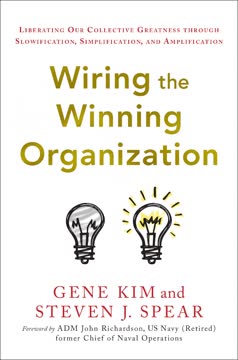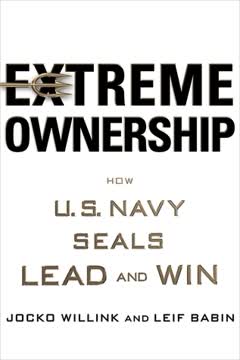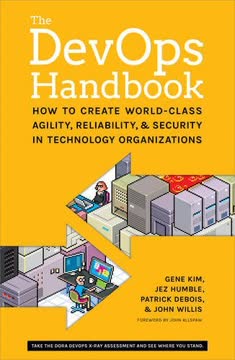Key Takeaways
1. FinOps: Bridging Finance and Technology for Cloud Cost Optimization
FinOps is the practice of bringing financial accountability to the variable spend model of cloud, enabling distributed teams to make business trade-offs between speed, cost, and quality.
Cross-functional collaboration. FinOps represents a cultural shift in how organizations manage their cloud spending. It breaks down silos between finance, technology, and business teams, fostering collaboration and shared responsibility for cloud costs. This approach enables companies to make informed decisions about cloud usage, balancing the need for innovation with financial prudence.
Variable spend model. Unlike traditional IT infrastructure, cloud computing introduces a pay-as-you-go model, which can lead to unexpected costs if not managed properly. FinOps practices help organizations adapt to this new paradigm by:
- Providing real-time visibility into cloud spending
- Enabling teams to make informed decisions about resource allocation
- Fostering a culture of cost awareness across the organization
Continuous improvement. FinOps is not a one-time implementation but an ongoing process of refinement and optimization. It encourages organizations to continually assess their cloud usage, identify areas for improvement, and adapt to changing business needs and technological advancements.
2. The FinOps Lifecycle: Inform, Optimize, Operate
The lifecycle is inherently a loop. The most successful companies take a Crawl, Walk, Run approach and get a little better each time they go through it.
Inform phase. This initial stage focuses on gaining visibility into cloud spending and usage patterns. Key activities include:
- Collecting and analyzing cloud billing data
- Identifying cost drivers and trends
- Establishing baseline metrics for future comparison
Optimize phase. Based on insights gained from the inform phase, organizations work to improve their cloud cost efficiency. This involves:
- Identifying opportunities for cost savings (e.g., rightsizing, reserved instances)
- Setting optimization goals and KPIs
- Implementing cost-saving measures
Operate phase. This stage is about implementing and maintaining FinOps practices across the organization. Key aspects include:
- Establishing governance policies and procedures
- Automating cost optimization processes where possible
- Continuously monitoring and refining FinOps practices
The FinOps lifecycle is iterative, with each cycle building upon the insights and improvements from the previous one. This approach allows organizations to gradually mature their FinOps practices and adapt to changing cloud environments and business needs.
3. Cost Allocation: Tagging and Account Strategies
Without a consistent allocation strategy, you have a big pool of costs with no way to split them up or to identify what costs belong to which team.
Tagging strategies. Implementing a comprehensive tagging strategy is crucial for accurate cost allocation. Effective tagging allows organizations to:
- Attribute costs to specific projects, teams, or business units
- Identify underutilized or orphaned resources
- Enable granular reporting and analysis of cloud spending
Account structures. In addition to tagging, proper account structures can aid in cost allocation. This may involve:
- Creating separate accounts for different departments or projects
- Implementing a hierarchy of accounts to reflect organizational structure
- Utilizing features like AWS Organizations or GCP Folders for centralized management
Best practices:
- Develop a consistent tagging policy across the organization
- Automate tag enforcement where possible
- Regularly audit and clean up tags to ensure accuracy
- Combine tagging and account structures for comprehensive cost allocation
Effective cost allocation not only provides visibility into spending but also fosters accountability among teams and enables more accurate budgeting and forecasting.
4. Rightsizing: Optimizing Resource Usage
Rightsizing is a very intimate thing and long process. Engineers sweat over their infrastructure. It's not as easy to say, "Well, it should be on a bigger or smaller instance."
Understanding utilization. Rightsizing involves analyzing resource utilization patterns to ensure that instances are appropriately sized for their workloads. This process requires:
- Collecting detailed performance metrics (CPU, memory, I/O)
- Identifying underutilized or overprovisioned resources
- Considering both performance requirements and cost implications
Implementing changes. Once rightsizing opportunities are identified, organizations must carefully plan and execute changes:
- Test changes in non-production environments first
- Consider the impact on application performance and user experience
- Implement changes gradually to minimize risk
Continuous monitoring. Rightsizing is an ongoing process, not a one-time event:
- Regularly review resource utilization patterns
- Adjust instance sizes as workload requirements change
- Consider using auto-scaling to dynamically adjust resources based on demand
Rightsizing can lead to significant cost savings, but it requires a delicate balance between cost optimization and performance. Successful implementation often involves close collaboration between FinOps practitioners and engineering teams.
5. Reserved Instances and Committed Use Discounts: Balancing Flexibility and Savings
When it comes to RI commitments, a year is not a year and three years is not three years.
Understanding commitment options. Reserved Instances (RIs) and Committed Use Discounts (CUDs) offer significant savings in exchange for longer-term commitments:
- RIs typically offer 1-3 year terms with varying upfront payment options
- CUDs provide discounts for committing to use a certain amount of resources over time
- Different providers offer varying levels of flexibility and exchange options
Balancing savings and flexibility. Organizations must carefully consider their needs when making commitments:
- Analyze historical usage patterns to inform commitment decisions
- Consider future growth and potential changes in resource requirements
- Evaluate the trade-offs between higher discounts and less flexibility
Managing a commitment portfolio. Effective RI/CUD management involves:
- Regularly reviewing and optimizing commitments
- Balancing coverage across different resource types and regions
- Considering convertible options for greater flexibility
- Implementing a centralized management approach for larger organizations
While RIs and CUDs can provide substantial savings, they require careful planning and ongoing management to maximize their benefits without overcommitting or limiting future flexibility.
6. Metric-Driven Cost Optimization: Data-Informed Decision Making
For MDCO, target lines are key. We've always been firm believers that no graph should be without a target line.
Establishing key metrics. Metric-Driven Cost Optimization (MDCO) relies on identifying and tracking relevant performance indicators:
- Define metrics that align with business goals and cloud usage patterns
- Establish baselines and set realistic targets for improvement
- Ensure metrics are measurable and actionable
Data-driven decision making. MDCO empowers organizations to make informed decisions about cloud spending:
- Use real-time data to identify optimization opportunities
- Set alerts for anomalies or deviations from targets
- Prioritize optimization efforts based on potential impact and effort required
Continuous improvement cycle:
- Collect and analyze performance data
- Identify areas for improvement
- Implement changes
- Monitor results
- Adjust strategies based on outcomes
By basing decisions on concrete data and measurable targets, MDCO helps organizations move beyond ad-hoc optimization efforts and towards a more systematic approach to cloud cost management.
7. Unit Economics: Aligning Cloud Spend with Business Value
Unit economics provides teams the data they need to measure—using the NSM—how an infrastructure change will impact costs.
Defining unit metrics. Unit economics involves tying cloud spend to specific business outcomes or units of value:
- Identify key business metrics (e.g., cost per user, transaction, or API call)
- Align cloud spending with these metrics to understand the true cost of delivering value
- Consider both direct costs and indirect benefits when evaluating cloud investments
Making informed decisions. Unit economics enables organizations to:
- Evaluate the ROI of cloud investments more accurately
- Make data-driven decisions about where to allocate resources
- Justify increased spending when it leads to proportional business value
Evolving metrics. As businesses grow and change, so should their unit economic metrics:
- Regularly review and refine metrics to ensure they remain relevant
- Consider multiple metrics for complex organizations or product lines
- Incorporate both financial and non-financial measures of value
By focusing on unit economics, organizations can move beyond simply managing costs to optimizing the value delivered by their cloud investments.
8. Containerization: Adapting FinOps Principles to New Technologies
The problems with containers are similar to the issues you initially face when moving into the cloud, so you can use the existing FinOps practices to solve these issues.
New challenges. Containerization introduces unique cost allocation and optimization challenges:
- Shared resources make traditional cost allocation methods less effective
- Dynamic scaling can lead to rapid changes in resource utilization
- Container orchestration adds another layer of complexity to cost management
Adapting FinOps practices. Organizations can apply FinOps principles to containerized environments by:
- Implementing container-specific tagging and labeling strategies
- Developing methods for allocating shared resource costs
- Optimizing container sizing and placement for cost efficiency
Considerations for container cost management:
- Monitor both cluster-level and container-level metrics
- Implement governance policies for container resource allocation
- Evaluate the cost implications of different container orchestration options
As containerization becomes more prevalent, organizations must evolve their FinOps practices to effectively manage costs in these dynamic environments. By adapting existing principles and developing new strategies, teams can maintain financial accountability while leveraging the benefits of containerization.
Last updated:
Review Summary
Cloud FinOps receives generally positive reviews, with an average rating of 4.10 out of 5. Readers praise it as an excellent introduction to FinOps, providing valuable insights for cloud cost management and certification preparation. The book is commended for its clear explanations, real-world examples, and comprehensive coverage of FinOps concepts. Some readers find it particularly useful for beginners, while others note its limitations for experienced practitioners. The book's ending, which touches on work-life balance, resonates strongly with several reviewers. A few criticisms include a lack of technical depth and repetitive justification for the field.
Similar Books










Download PDF
Download EPUB
.epub digital book format is ideal for reading ebooks on phones, tablets, and e-readers.




